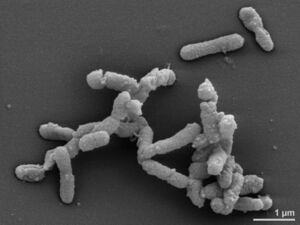Alistipes finegoldii
Classification
Higher order taxa
Domain: Bacteria
Class: Bacteroidia
Order: Bacteroidales
Family: Rikenellaceae (1)
Species
Alistipes finegoldii NCBI: Taxonomy
Description and Significance
Alistipes finegoldii is a commensal anaerobe that is gram-negative, rod-shaped, and non spore forming bacteria (2) that are found primarily in the gastrointestinal tract (3). This is a relatively new genus of bacteria, first discovered in tissue samples of children with appendicitis (4). So far, the Alistipes genus contains 13 species, all of which besides A.obesi are non-motile (2). The discovery of Alistipes bacteria has become essential in clinical research, as it has been shown to have both possible protective effects against diseases and pathogenetic dysbiotic effects. Studying Alistipes can provide more insight on the relationship of bacteria-host symbiosis in the gut and other areas of the body as well. Furthermore, its continuous study will contribute to how we understand Alistipes and its relationship to human health (2).
Genome Structure
Describe the size and content of the genome. How many chromosomes? Circular or linear? Other interesting features? What is known about its sequence? (add more/and link w sources; italicize)
The genus Alistipes is part of the Bacteroidetes phylum branch within the family Rikenellaceae (source) Closely related species Alistipes onderdonkii ; (add more) Isolates from human appendiceal tissues finegoldii chromosomes are circular shaped with high DNA G+C content of 56.65% . Consist of 3,302 total genes, 3234 protein coding genes and 68 RNA genes.
Cell Structure, Metabolism and Life Cycle
Interesting features of cell structure; how it gains energy; what important molecules it produces.
Rod-shaped non motile gram negative bacteria with an incubation period of 1-2 days. Strictly anaerobic, indole-positive, metabolism is fermentative / mesophilic (describe little more)
fatty acid biosynth info diff compared to other gut microbes.....
Ecology and Pathogenesis
Habitat; symbiosis; biogeochemical significance; contributions to environment.
If relevant, how does this organism cause disease? Human, animal, plant hosts? Virulence factors, as well as patient symptoms.
Alistipes finegoldii is found ubiquitously in the gastrointestinal tract...... There is contrasting evidence regarding Alistipes pathogenicity. Recent studies show that there are links between Alistipes and the protection against colitis, liver fibrosis (cirrhosis), and cardiovascular disease. On the other hand, different studies have found that Alistipes is the pathogen responsible for colorectal cancer and is linked to mental health issues such as depression. (explain each case)
References
(5)Gut microbial carbohydrate metabolism contributes to insulin resistance
(7)Sulfonolipids as novel metabolite markers of Alistipes and Odoribacter affected by high-fat diets
Author
Page authored by Virginia Powell & Max Plodzik, students of Prof. Jay Lennon at Indiana University.

